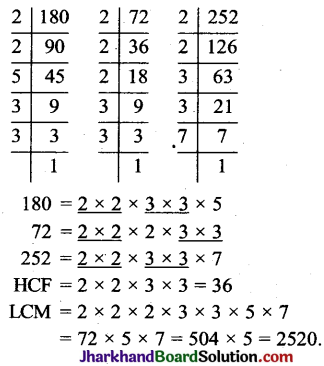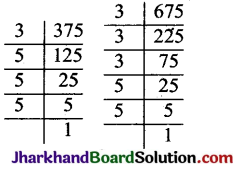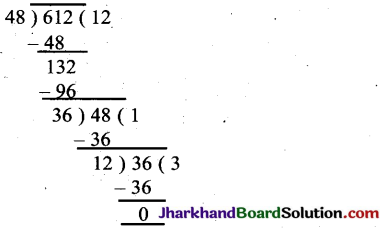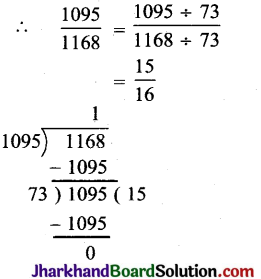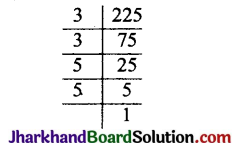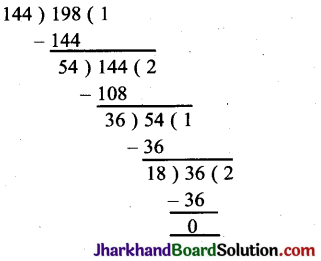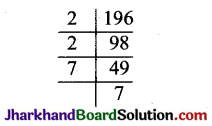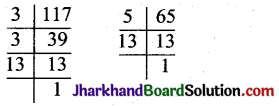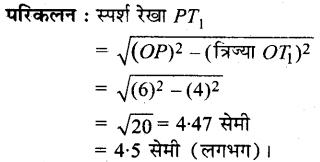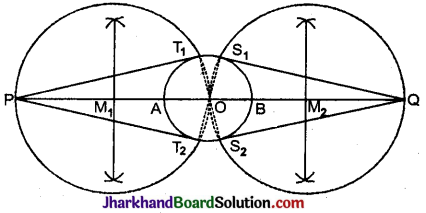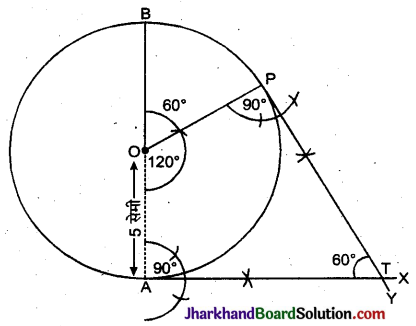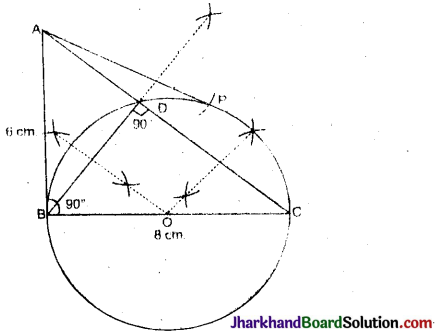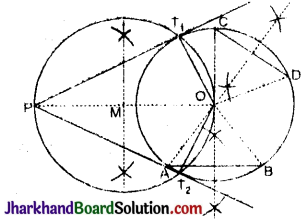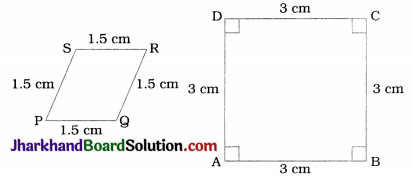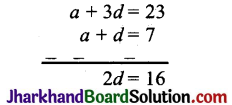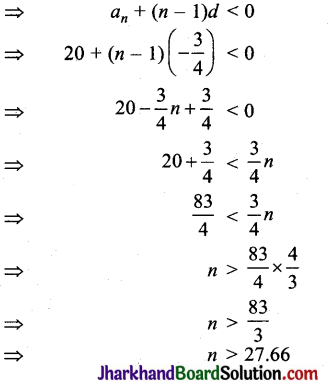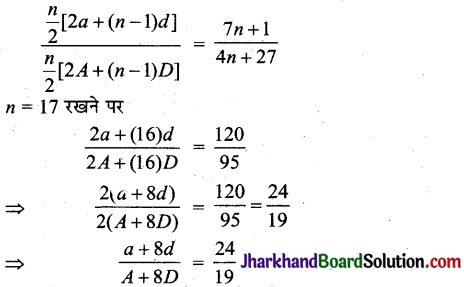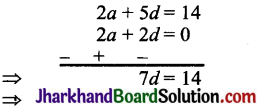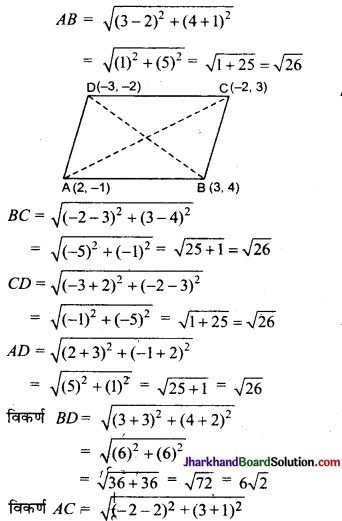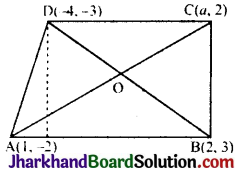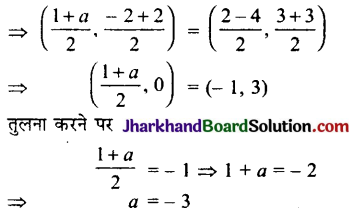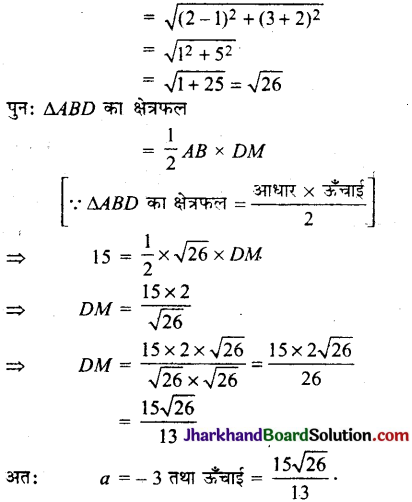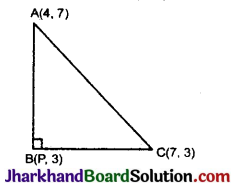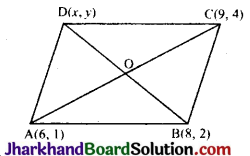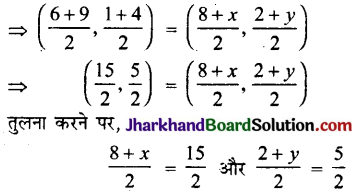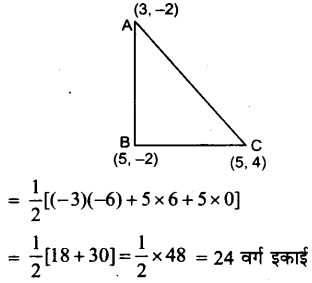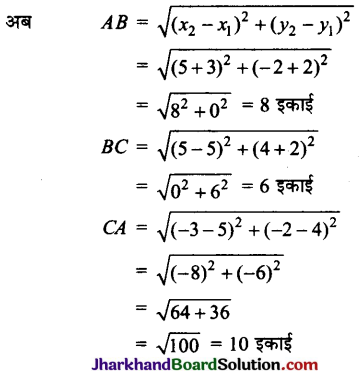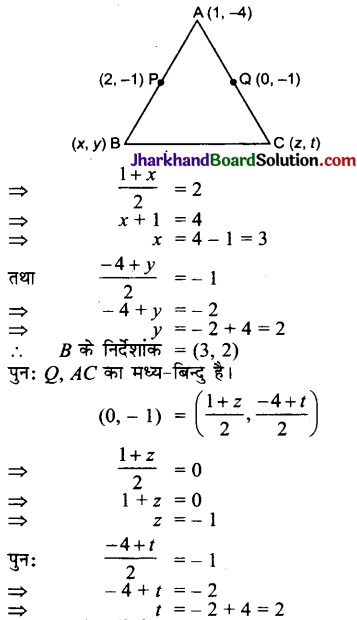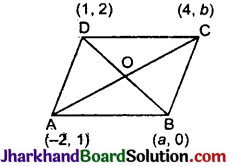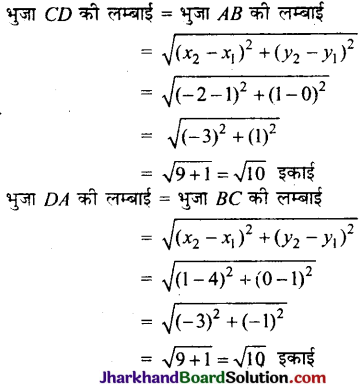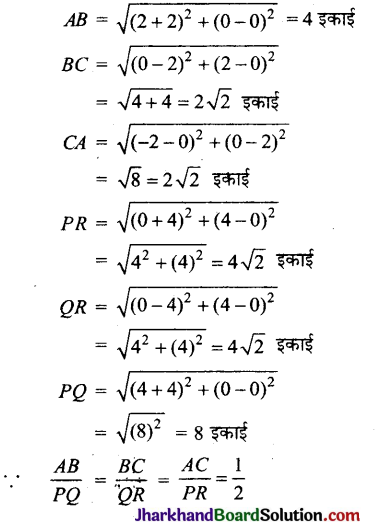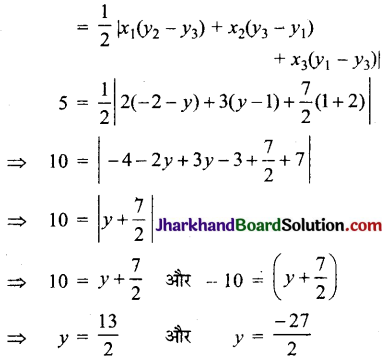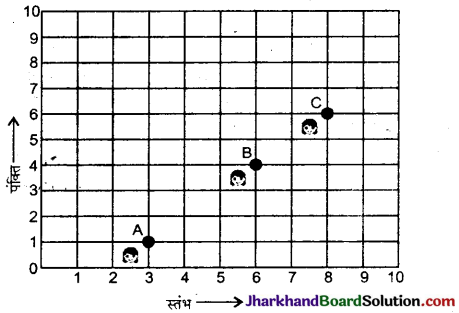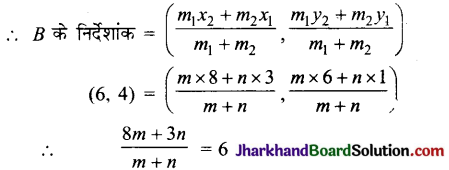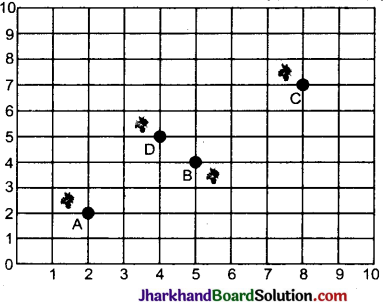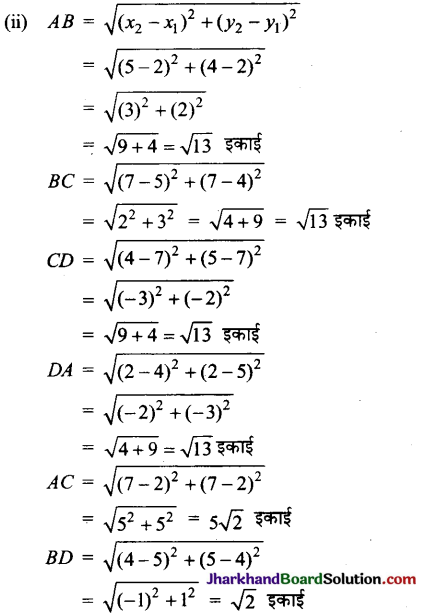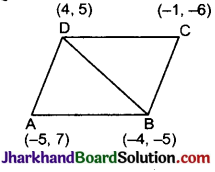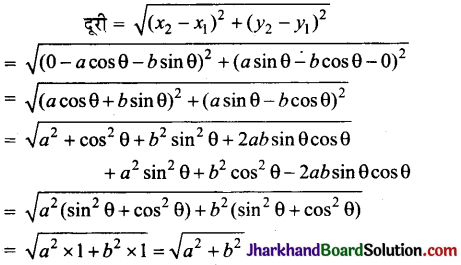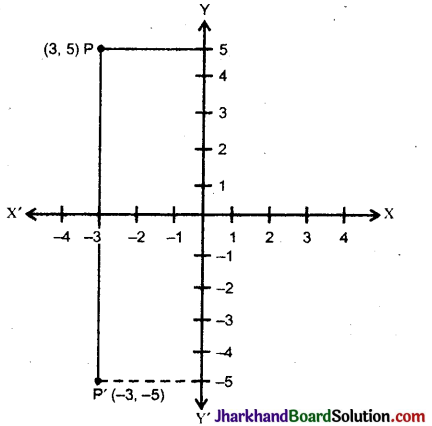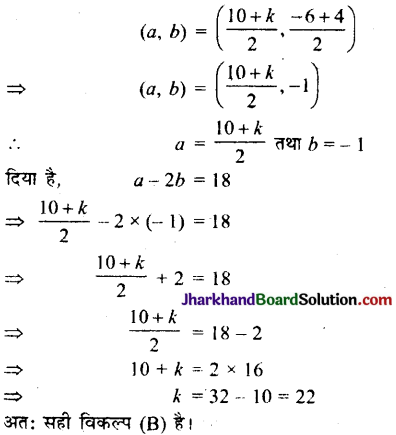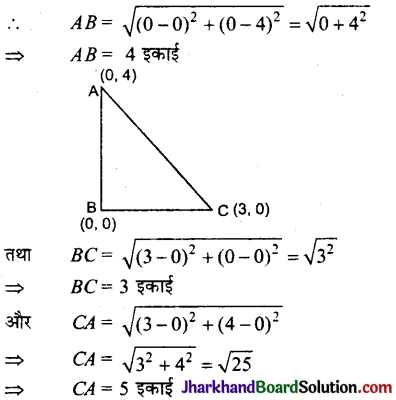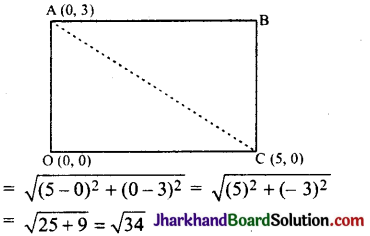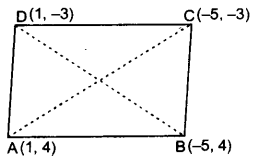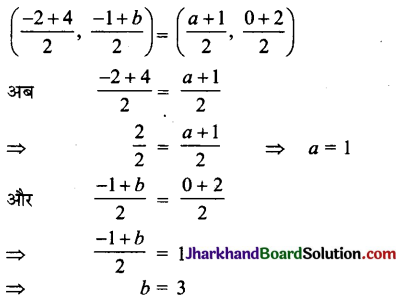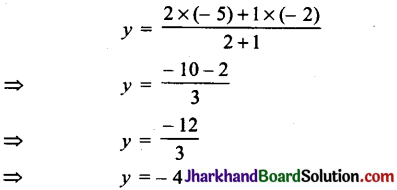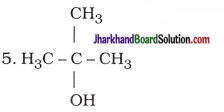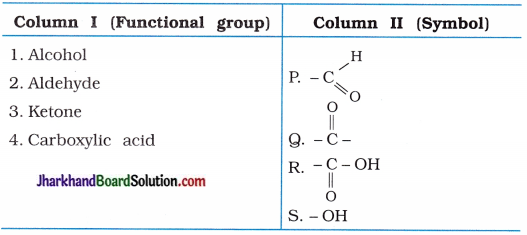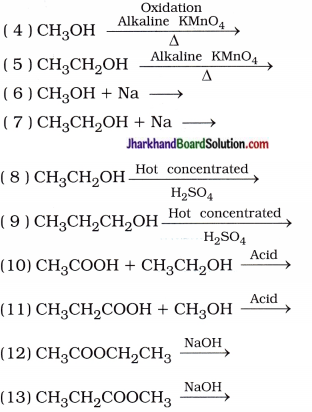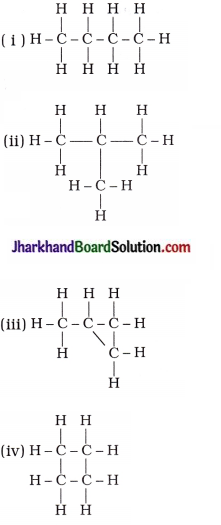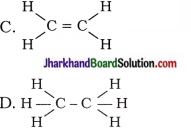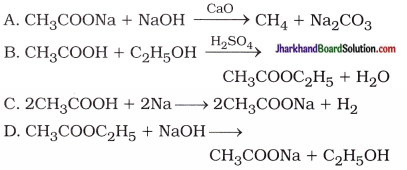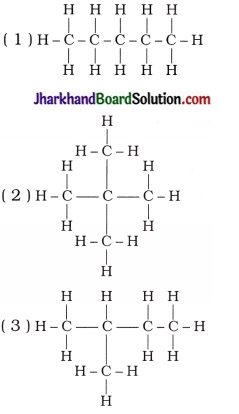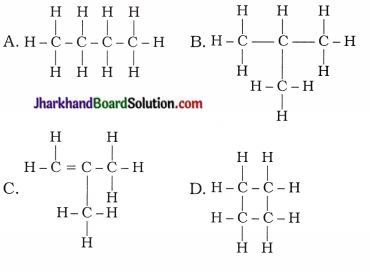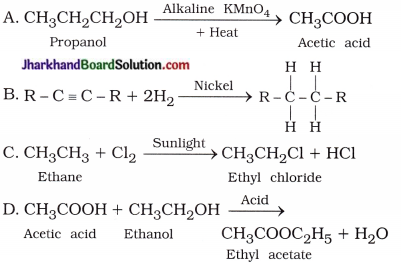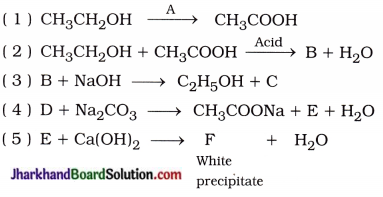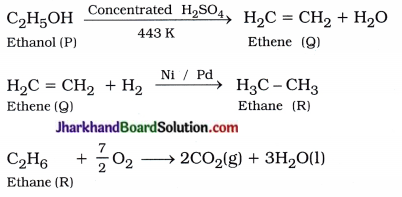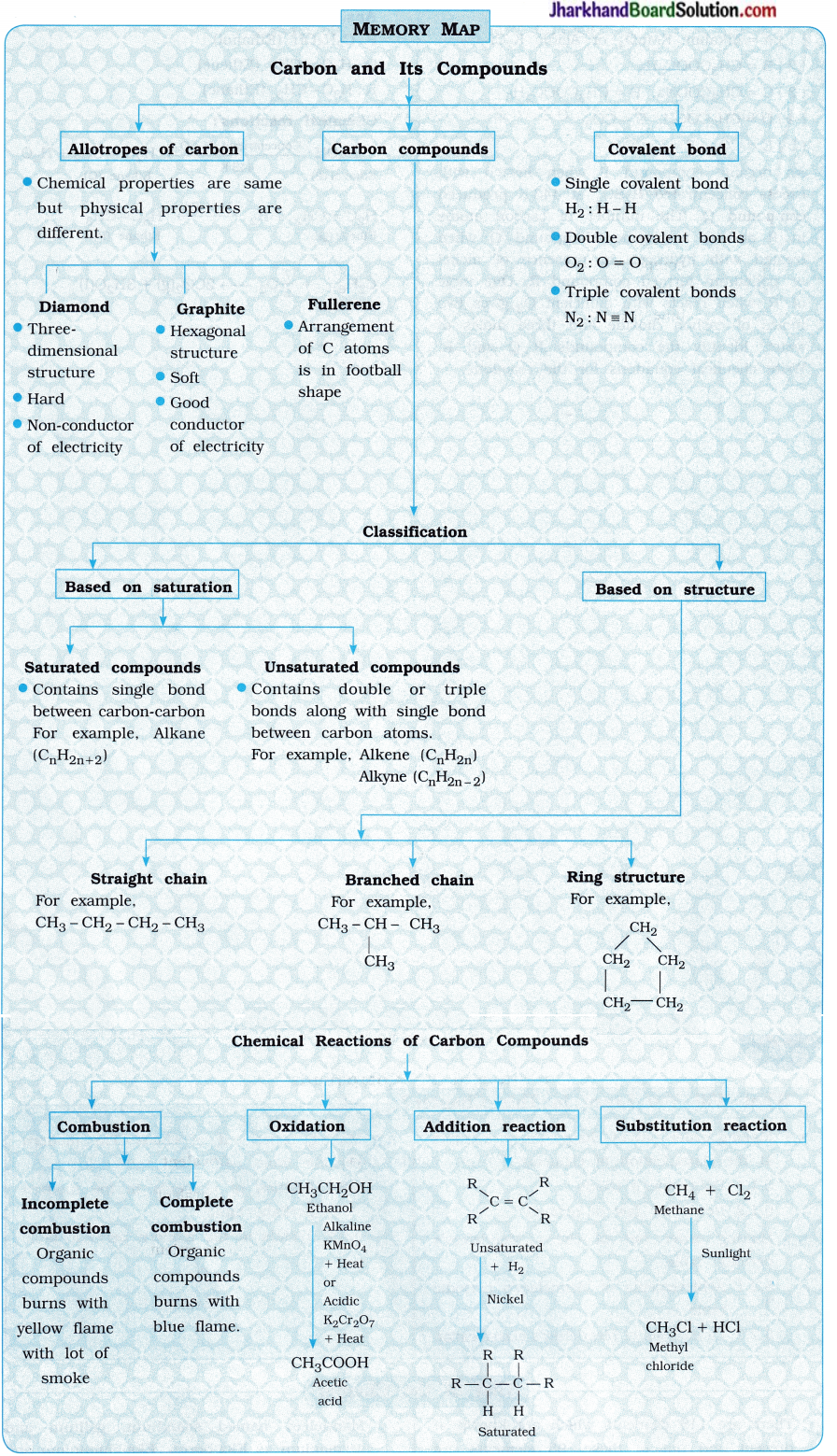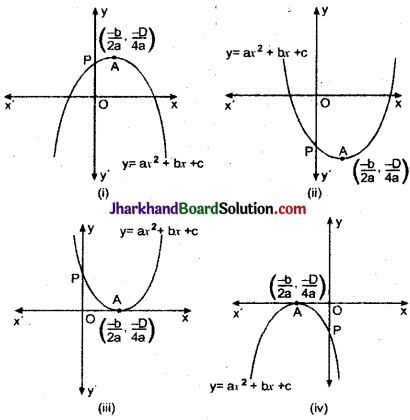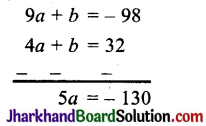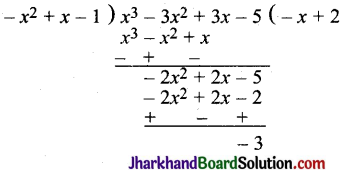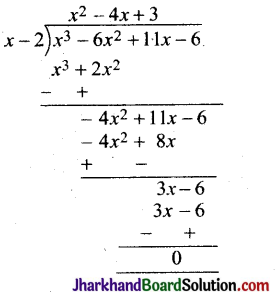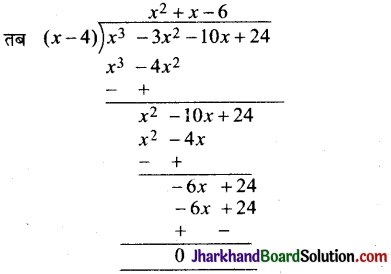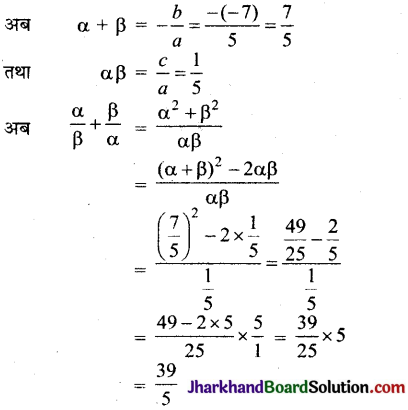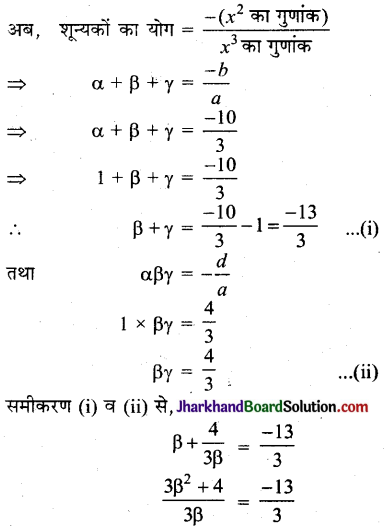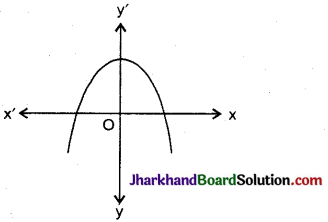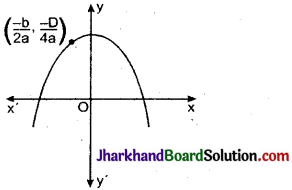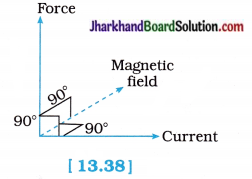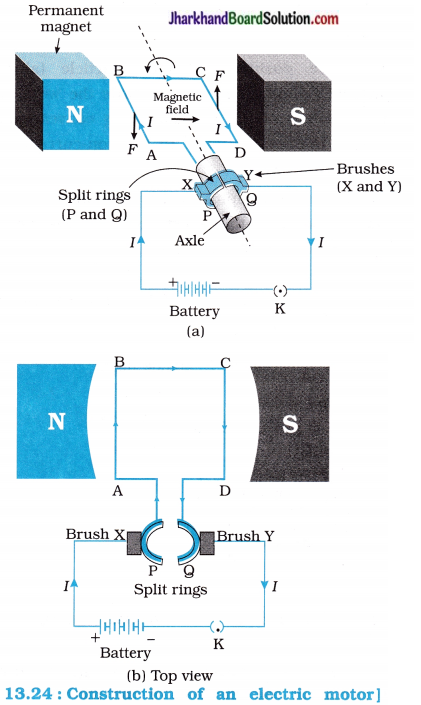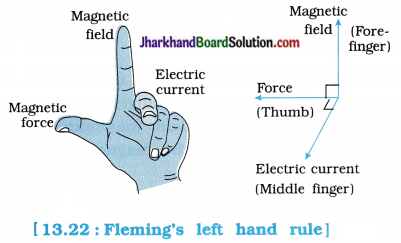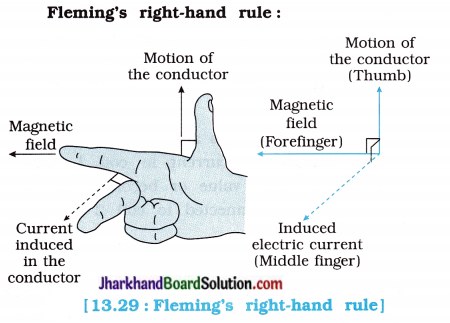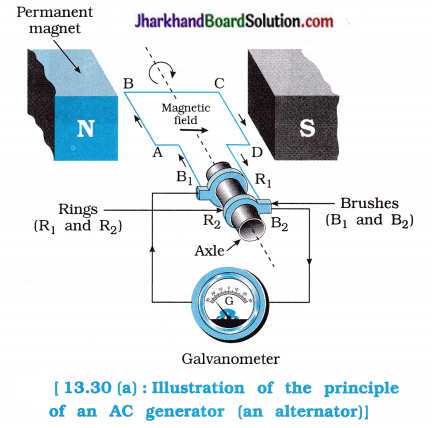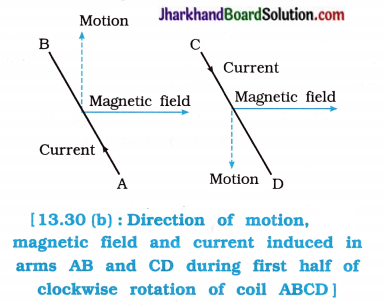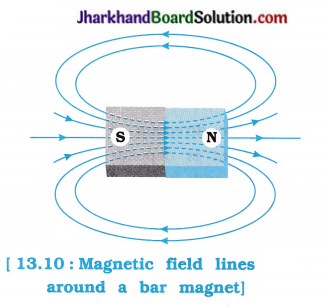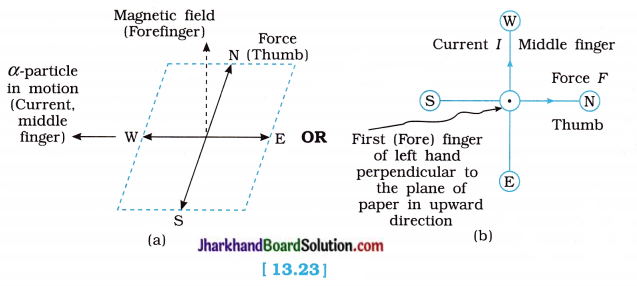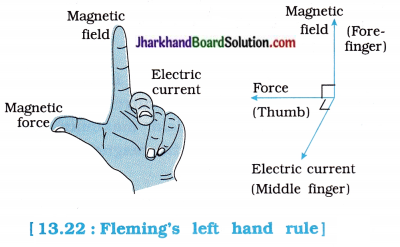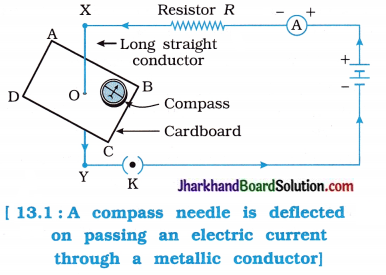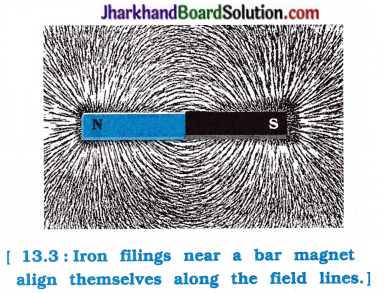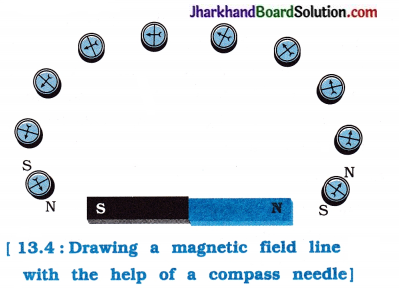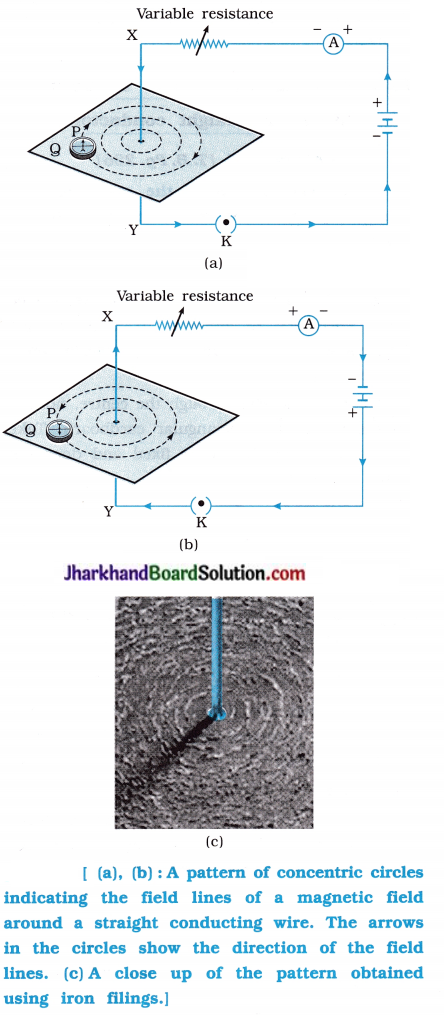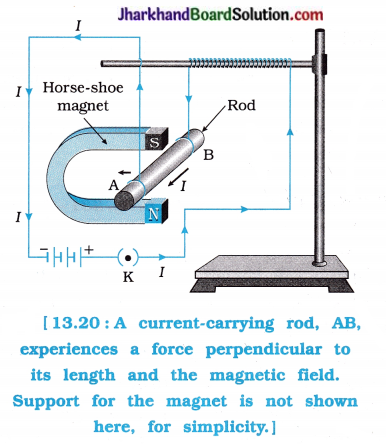Jharkhand Board JAC Class 10 Science Important Questions Chapter 11 Human Eye and Colourful World Important Questions and Answers.
JAC Board Class 10 Science Important Questions Chapter 11 Human Eye and Colourful World
Additional Questions and Answers
Question 1.
Give four points of difference between the following terms / quantities :
(1) Near-sightedness and Far-sightedness
Answer:
| Near-sightedness | Far- sightedness |
| 1. The eye lens does not become thin as required but remains thick. | 1. The eye lens does not become thick as required but remains thin. |
| 2. The light rays from objects at far distances are focused short of the retina. As a result, the distant objects cannot be seen clearly. | 2. The light rays from objects nearby the eyes are focused behind the retina. As a result the nearby objects cannot be seen clearly. |
| 3. The light rays from objects nearby eyes are focused on the retina. As a result, the nearby objects are seen clearly. | 3. The light rays from distant objects are focused on the retina. As a result the distant objects are seen clearly. |
| 4. This defect can be corrected by using concave lens of appropriate focal length. | 4. This defect can be corrected by using convex lens of appropriate focal length. |
(2) Near point and Far point
Answer:
| Near point | Far point |
| 1. The minimum distance at which the object can be seen clearly without contraction of eye lens is called the near point of an eye. | 1. The farthest distance upto which the eye can see objects clearly is called far point of an eye. |
| 2. For young adult with normal vision, this value is 25 cm. | 2. For young adult with normal vision, this value is infinite. |
| 3. For a person having defect of far-sightedness value of the near point is at a distance more than 25 cm. | 3. For a person having defect of near-sightedness value of the far point is at a distance less than infinite distance. |
| 4. For a person having defect of far-sightedness value of the near point is obtained at a distance of 25 cm using convex lens of appropriate focal length. | 4. For a person having defect of near-sightedness value of the far point is obtained at distance of infinite distance using concave lens of appropriate focal length. |
Question 2.
Give scientific reasons for the following statements:
(1) To rectify the defect of near-sightedness or myopia, concave lens of suitable focal length is used as corrective lens.
Answer:
The eye lens of a person having defect of near-sightedness or myopia, does not become thin as per the requirement and so the rays after being refracted by the eye lens get focussed at a position short of retina. So distant objects cannot be seen clearly.
If a person having defect of near-sightedness, uses concave lens of suitable focal length, then light rays become slightly divergent. Hence, the image can be formed on retina.
Thus, if the image is formed on retina, then the distant object may be seen clearly.
(2) To rectify the defect of far-sightedness or hypermetropia, convex lens of suitable focal length is used as corrective lens.
Answer:
The eye lens of a person having defect of far-sightedness as hypermetropia, does not become thick as per the requirement and so the rays after being refracted by the eye lens get focussed behind retina. So nearby objects cannot be seen clearly.
If a person having defect of far-sightedness, uses convex lens of suitable focal length, then light rays become slightly convergent. Hence, the image can be formed on retina.
Thus, if the image is formed on retina, then the nearby object may be seen clearly.
![]()
(3) A rainbow is visible in the sky only after rain shower.
Answer:
In rainy season there are many clouds in the sky having tiny water droplets. When the sunlight is incident on tiny water droplets, due to these tiny water droplets, refraction, dispersion, internal reflection and at the end again refraction of sunlight take place.
Due to which a band is created which contains seven colours in the sky which is known as rainbow.
In other seasons there are no clouds in the sky. Therefore there are no tiny water droplets s in the sky. Hence, no rainbow is formed in the sky in other seasons and so it is not visible in? the sky.
(4) The sunrise is experienced two minutes early and the sunset is experienced two minutes delayed.
Answer:
As the altitude (height) from the earth’s surface gradually increases, the earth’s atmosphere becomes rarer. Hence, the refractive index of the air decreases continuously.
So a ray of light coming from the Sun towards an observer continuously passes from an optically rarer to optically denser medium and bends towards the normal. Thus, its direction of propagation changes continuously.
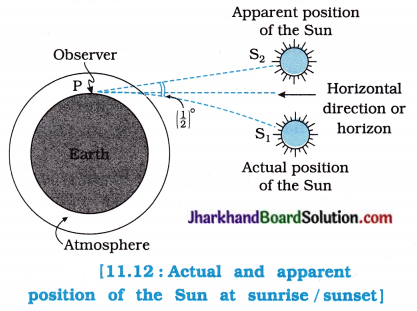
The actual sunrise or sunset begins when the Sun reaches the horizon.
1. In figure 11.12, S1 is the actual position of the Sun a little below the horizon.
2. In this case, the light rays coming from S1, continuously get refracted in the earth’s atmosphere (atmospheric refraction) and reach the observer as shown in the figure.
3. The tangent drawn to the curved path of the ray at point P passes through S2, above the horizon.
4. S2 is the apparent position of the Sun.
5. Thus, during the sunrise, the Sun is seen even though it is little below the horizon. Similarly, during the sunset it is seen for sometime even though it is little below the horizon.
6. Taking the refractive index of air as 1.00029 the apparent angular shift in the position of the Sun is found to be approximately (\(\frac { 1 }{ 2 }\))°.
Now, for angular displacement of 180° of the Sun, time required is 12 hours. Hence for angular displacement of (\(\frac { 1 }{ 2 }\))° of the Sun, time required is
= \(\frac{\left(\frac{1}{2}\right)^{\circ} \times 12 \text { hours }}{180^{\circ}}\)
= 0.03333 hour
= 1.9998 minutes
≈ 2 minutes
Due to advance sunrise and delayed sunset the duration of a day increases by about 4 minutes.
(5) The clear sky appears blue in colour.
Answer:
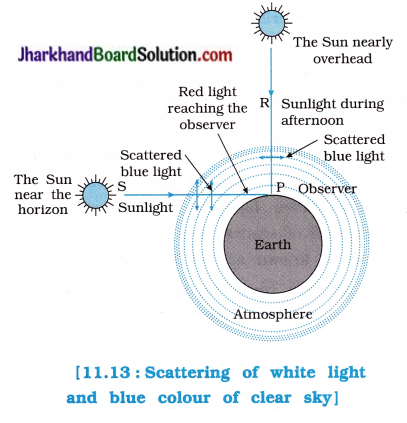
The molecules of air and other fine particles in the atmosphere are smaller in size than the wavelength of light in the visible region.
- The wavelength of red light is about 1.8 times that of blue light.
- When the sunlight passes through the atmosphere, the fine particles in the air scatter blue light more strongly than red light.
- At this time if the observer looks upwards, he finds sky blue.
- If the earth had no atmosphere, there would not have been any scattering. Then the sky would have looked dark.
Important Note:
The sky appears dark to passengers flying at very high altitudes, as scattering of light is not prominent at such heights.
![]()
(6) The danger signal lights are red in colours.
Answer:
The red light gets scattered least by fog or smoke because of its longer wavelength relative to light of any other colour. So, it can be seen even from a long distance. Therefore it is used in signals showing danger.
(7) The sun appears reddish at sunrise and sunset.
Answer:

In figure 11.14, the situation at the sunrise is shown.
Here, the white light coming from the Sun near the horizon, passes through thick layers of air and covers larger distance in the earth’s atmosphere before reaching the observer. During this, more scattering of blue light and shorter wavelengths take place. Hence, the reddish light reaches the observer and the Sun appears reddish. The same thing occurs at the sunset.
[Note : Rising and setting of the full moon from the horizon appears reddish due to this reason.]
Objective Questions and Answers
Question 1.
Answer the following questions in one word / sentence :
Question 1.
What is dispersion of white light?
Answer:
The phenomenon of a splitting of white light into its constituent colours is called the dispersion of white light.
Question 2.
What happens to the image-distance in the normal eye, when we increase the distance of an object from the eye?
Answer:
The image distance always remains constant.
Question 3.
What can be said about the focal length of the eye lens if its curvature increases?
Answer:
decreases
Question 4.
What can be said about the curvature of the eye lens if it becomes thin?
Answer:
decreases
Question 5.
For normal eye vision what is the object-distance and image-distance when the object is placed at a near point? (Take the distance between the eye lens and the retina as 2.3cm.)
Answer:
u = – 25 cm, v = + 2.3 cm
Question 6.
For normal eye vision what is the object-distance and image-distance when the object? is placed at a far point? (Take the distance between the eye lens and the retina as 2.3 cm.)
Answer:
u = – 00, a = + 2.3 cm
Question 7.
State the type of image of an object formed s on the retina.
Answer:
real, inverted and diminished
Question 8.
Write the name of the most front part of human eye.
Answer:
cornea
Question 9.
State the function of the iris.
Answer:
Iris can control the amount of light entering into the eye as well as size of pupil can be controlled by it.
Question 10.
State the function of light sensitive cells present in retina.
Answer:
Light rays falling on the retina are converted into the electrical signals.
Question 11.
Write the function of optic nerves.
Answer:
The work of optic nerves is to sent electrical signals to the brain.
Question 12.
Write use of bifocal lens.
Answer:
To rectify/remove the eye-defect known as presbyopia.
Question 13.
How much duration in second increases per day due to early sunrise and delayed sunset?
Answer:
240s
Question 14.
Due to which effect does the smoke emitted by the combustion of the engine oil in a motorcycle sometimes appears blue in colour?
Answer:
The Tyndall effect
Question 15.
Which effect is developed commercially to determine the size and density of aerosol and other colloidal particles?
Answer:
The Tyndall effect
Question 16.
Wavelength of red colour is approximately how many times the wavelength of violet colour?
Answer:
1.8
Question 2.
Fill in the blanks :
- The type of image formed by the eye lens is ………………. and ……………….
- A triangular glass prism has ………………. triangular bases and ………………. rectangular surfaces.
- Light enters our eye through the ……………….
- A person suffering from far-sightedness or hypermetropia cannot see clearly ………………. objects.
- A ………………. corrective lens is used to rectify near-sightedness.
- An old person suffering from near-sightedness and a far-sightedness uses ………………. to rectify his vision.
- While passing through the prism the light ray travelling from air to glass bends towards the ……………….
- In a glass prism ………………. light propagates with maximum speed.
- At night stars are seen slightly at a higher position than their actual position because of the ……………….
- For a light ray passing through the prism, the angle between the incident ray and the emergent ray is known as the ……………….
- At the time of sunrise the sun appears ………………. in colour.
- The fine particles in air scatter ………………. light more strongly.
- ………………. light, while passing through a prism, does not disperse.
- Stars behave like ………………. sources of light and planets behave like ………………. sources of light.
- Danger signals are red in colour because red light is ……………….
- In the spectrum of white light, ………………. and ………………. colours seen at the two ends.
- The diameter of the human eyeball is approximately ………………. cm.
- The distance between the eye lens and the retina is known as the ……………….
- In the normal situation in the relaxed position of the ciliary muscles, the eye lens is ……………….
- At night as we move up in the atmosphere of the earth, the refractive index ………………. continuously.
Answer:
- real, inverted
- two, three
- cornea
- nearby
- concave / diverging
- spectacles with bi-focal lenses
- normal
- red
- atmospheric refraction
- angle of deviation
- reddish
- blue
- Monochromatic (It means light of single frequency, i.e., of single colour.
- point, extended
- scattered the least
- violet, red
- 2.3
- size of the eyeball
- thin
- decreases
Question 3.
State whether the following statements are true or false:
- The near point of every person is 25 cm.
- The splitting of white light into its constituent colours is called the scattering of light.
- Far-sightedness can be rectified by using a concave lens of suitable power.
- In the eye of myopic person, the image of a distant object is formed behind the retina.
- Near-sightedness arises due to more curvature of the cornea or due to the eye lens remaining thick permanently.
- The speed of light decreases as it passes from an optically denser medium to an optically rarer medium.
- A myopic person has the far point nearer than infinity.
- A hypermetropic person has near point farther away from the normal near point (25 cm).
- The construction of the human eye can be compared with that of a camera.
- A rainbow is formed due to refraction taking place twice, one internal reflection and dispersion of sunlight by water droplets in the sky.
- Planets twinkle.
- When the sunlight passes through a canopy of dense forest, tiny water droplets in the mist, scatter the light. This effect is known as the Tyndall effect.
Answer:
- False
- False
- False
- False
- True
- False
- True
- True
- True
- True
- False
- True
Question 4.
Match the following:
(1)
| Column I | Column II | Column III |
| 1. Myopia | p. The focal length of the eye lens increase | a. Bifocal lens |
| 2. Hypermetropia | q. The focal length of the eye lens decrease | b. Concave lens |
| 3. Presbyopia | r. The power of accommodation of the eye decrease with ageing | c. Convex lens |
Answer:
(1 – q – b), (2 – p – c), (3 – r – a).
(2)
| Column I | Column II |
| 1. TWinkling of stars | p. Tiny water droplets present (or suspended) in the atmosphere |
| 2. Blue coloured sky | q. Band of colours |
| 3. Rainbow | r. Scattering of light |
| 4. Spectrum | s. Uneven atmosphere |
Answer:
(1 – s), (2 – r), (3 – p), (4 – q).
(3)
| Column I | Column II |
| 1. Human eye or eyeball | a. It controls and regulates the amount of light entering the eye. |
| 2. Self operated accommodation power of eye | b. Delicate membrane having large number of light sensitive cells. |
| 3. Retina | c. Works as a photographic camera. |
| 4. Ciliary muscles | d. Not able to see the nearby objects. |
| 5. Myopia | e. Electrical signals related to image are sent to the brain. |
| 6. Cataract | f. A circular muscular diaphragm which can control the size of pupil. |
| 7. Presbyopia | g. Milky and cloudy layer is formed on the eye lens. |
| 8. Iris | h. The capacity of eye to see objects clearly between 25 cm and infinite distance. |
| 9. Pupil | i. Increases or decreases curvature of eye lens. |
| 10. Optic nerves | j. Image of object at infinite distance is formed in front of retina. |
| 11. Hypermetropia | k. Accommodation power of eye decreases with ageing. |
Answer:
(1 – c), (2 – h), (3 – b), (4 – i), (5 – j), (6 – g), (7 – k), (8 – f), (9 – a), (10 – e), (11 – d).
![]()
Question 5.
Choose the correct option from those given below each question:
1. Splitting of white light into its seven constituent colours is called ……………
A. refraction
B. reflection
C. dispersion
D. interference
Answer:
C. dispersion
2. Which colour of light deviates maximum in the dispersion of white light by a prism?
A. Violet
B. Blue
C. Green
D. Red
Answer:
A. Violet
3. In the human eye, the image of an object is formed at the ……………….
A. iris
B. pupil
C. retina
D. cornea
Answer:
C. retina
4. The focal length of the eye lens is changed due to the action of the ……………….
A. pupil
B. retina
C. ciliary muscles
D. cornea
Answer:
C. ciliary muscles
5. A ………………. lens is used to correct presbyopia.
A. convex
B. concave
C. bi-focal
D. contact
Answer:
C. bi-focal
6. Out of the following, which phenomenon does not play a role in the formation of a rainbow?
A. Reflection
B. Refraction
C. Dispersion
D. Absorption
Answer:
D. Absorption
7. Where is the image formed in the eye of a person suffering from near-sightedness?
A. On the retina
B. Behind the retina
C. In front of the retina
D. On the pupil
Answer:
C. In front of the retina
8. Which phenomenon is responsible for the twinkling of stars?
A. Atmospheric reflection
B. Atmospheric refraction
C. Reflection
D. Total internal reflection
Answer:
B. Atmospheric refraction
9. The phenomenon of ………………. of light by the colloidal particles gives rise to the Tyndall effect.
A. reflection
B. refraction
C. scattering
D. dispersion
Answer:
C. scattering
10. What is the time difference between actual sunset and apparent sunset?
A. 2 seconds
B. 20 seconds
C. 2 minutes
D. 20 minutes
Answer:
C. 2 minutes
11. Which light gets scattered maximum due to atmosphere?
A. Blue
B. Yellow
C. Green
D. Red
Answer:
A. Blue
12. Which light has minimum speed in glass (prism)?
A. Red
B. Green
C. Blue
D. Violet
Answer:
D. Violet
13. When an eye is focussed on a distant object, the focal length of the eye lens is ……………….
A. maximum
B. minimum
C. half of its minimum
D. half of its maximum
Answer:
A. maximum
14. How many surfaces does a triangular prism have?
A. 3
B. 4
C. 5
D. 6
Answer:
C. 5
15. The wavelengths of violet, yellow and red light are λv, λy and λr respectively, then ……………………..
A. λv > λy > λr
B. λv < λy < λr
C. λy < λv < λr
D. λy < λr < λv
Answer:
B. λv < λy < λr
![]()
16. For normal vision, the far point is at ……………… distance.
A. 25 cm
B. 1 cm
C. 1 m
D. infinite
Answer:
D. infinite
17. For normal vision, the near point is ………………
A. 25 cm
B. 25 m
C. zero
D. infinite
Answer:
18. Which phenomenon can explain the advance sunrise and the delayed sunset?
A. Dispersion of light
B. Scattering of light
C. Tyndall effect
D. Atmospheric refraction
Answer:
D. Atmospheric refraction
19. Which of the following phenomena cannot be explained by scattering of light?
A. The red light used for signal lights for danger.
B. Blue colour of clear sky
C. White colour of clouds
D. Early sunrise
Answer:
D. Early sunrise
20. The base of an equilateral triangle ABC is BC. When it is arranged in four different situations and white light is incident on it, then in which of the following arrangements of the prism, the third colour from the top is the colour of clear sky in dispersion of light is produced?
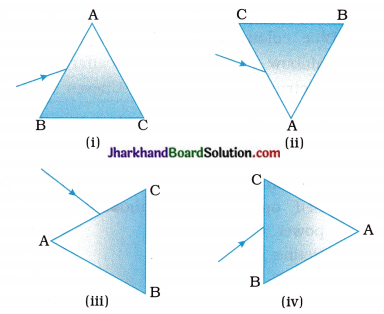
A. (i)
B. (ii)
C. (iii)
D. (iv)
Answer:
B. (ii)
Hint: The dispersion of white light is shown in arrangement (ii) of prism
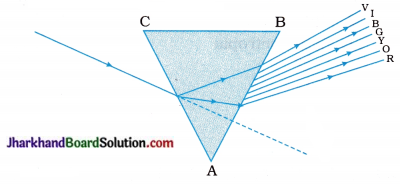
The third colour of light from the top is blue which is the colour of the clear sky.
21. The Sun appears white in afternoon. The reason is …
A. less scattering of light.
B. more scattering of all the colours of white light.
C. more scattering of blue colour.
D. more scattering of red colour.
Answer:
A. less scattering of light.
Hint: White light coming from the Sun has to travel less distance in the atmosphere before reaching the observer. So less scattering of light takes place and as a result the Sun appears white.
22. Sea water at more depth appears blue. The reason is …
A. presence of some plants in sea water.
B. the image of the sky appears in water.
C. scattering of light.
D. light is absorbed by sea water.
Answer:
C. scattering of light.
23. When the ciliary muscles are relaxed, the eye lens becomes …………….. and its focal length ……………… This enables us to see distant objects clearly.
A. thin, increases
B. thin, decreases
C. thick, increases
D. thick, decreases
Answer:
A. thin, increases
24. When the ciliary muscles contract, the eye lens becomes …………….. and its focal length ……………..
This enables us to see nearby objects clearly.
A. thick, decreases
B. thick, increases
C. thin, increases
D. thin, decreases
Answer:
A. thick, decreases
25. The rainbow on the moon ……………..
A. is not possible.
B. is rare.
C. is observed with the reverse order of colours.
D. is of two types.
Answer:
A. is not possible.
26. In dispersion of white light due to a triangular glass prism, the deviation of red colour is less compared to violet colour. The reason ………………
A. is nv > nr.
B. is nr > nv.
C. is nv = nr.
D. does not depend on n.
Answer:
A. is nv > nr.
Hint: In glass medium, speed of violet colour is less as compared to speed of red colour. So, nv > nr from n = \(\frac { c }{ v }\)
27. Which lens from the following, should a person suffering from near-sightedness use?
A. A convex lens
B. A concave lens
C. A cylindrical lens
D. A bi-focal lens
Answer:
B. A concave lens
28. Which lens is used by a person suffering from far-sightedness?
A. A convex lens
B. A concave lens
C. A cylindrical lens
D. A bi-focal lens
Answer:
A. A convex lens
29. Which of the following is true for near-sightedness?
A. Nearby objects cannot be seen clearly.
B. Distant objects cannot be seen clearly.
C. The eye lens cannot become thick as required.
D. This defect can be rectified using spectacles of convex lenses.
Answer:
B. Distant objects cannot be seen clearly.
30. Which of the following is true for far-sightedness?
A. Nearby objects cannot be seen clearly.
B. Distant objects cannot be seen clearly.
C. The eye lens cannot become thin as required.
D. This defect can be rectified using spectacles of concave lenses.
Answer:
A. Nearby objects cannot be seen clearly.
31. Where is the image formed in the eye of a person suffering from far-sightedness?
A. On the retina
B. Behind the retina
C. On the pupil
D. In front of the retina
Answer:
B. Behind the retina
32. A person has a defect of eye vision. His near point is 40 cm. It means …
A. he cannot clearly see objects at a distance more than 40 cm from the eye.
B. he can clearly see objects at a distance of 40 cm only.
C. he can clearly see objects at a distance equal to 40 cm or more from the eye.
D. he can clearly see objects at a distance less than 40 cm e.g., 25 cm from the eye.
Answer:
C. he can clearly see objects at a distance equal to 40 cm or more from the eye.
Hint: Here the person suffers from far-sightedness.
33. A person has a defect of vision. His far point is 1.5m. It means …
A. he cannot clearly see objects at a distance more than 1.5 m from the eye.
B. he can clearly see objects at a distance more than 1.5 m from the eye.
C. he cannot clearly see objects at a distance less than 1.5 m from the eye.
D. he suffers from far-sightedness.
Answer:
C. he cannot clearly see objects at a distance less than 1.5 m from the eye.
Hint: Here the person suffers from near-sightedness.
34. Out of the following, which light is deviated minimum in the dispersion of white light through a glass prism?
A. Green
B. Violet
C. Yellow
D. Dispersion of the given three colours is the same.
Answer:
C. Yellow
35. Which light has maximum speed in glass?
A. Violet
B. Blue
C. Green
D. Red
Answer:
D. Red
36. Which ray of light is present exactly at the middle of the spectrum obtained from white light?
A. Green
B. Yellow
C. Red
D. Violet
Answer:
A. Green
37. The lens in human eye is a …………….
A. convex mirror
B. convex lens
C. concave mirror
D. concave lens
Answer:
B. convex lens
38. For persons suffering from near-sightedness the power of the lens used in spectacles is …………….
A. positive
B. zero
C. negative
D. infinite
Answer:
C. negative
39. For a person suffering from ……………. the power of the lens used in spectacles is positive.
A. far-sightedness
B. near-sightedness
C. presbyopia
D. cataract
Answer:
A. far-sightedness
40. Which phenomenon/phenomena of light is/ are involved in the formation of a rainbow?
A. Refraction
B. Dispersion
C. Internal reflection
D. All of the given above
Answer:
D. All of the given above
41. ……………. light from the following is least scattered by fog, dust and smoke.
A. Violet
B. Blue
C. Red
D. Yellow
Answer:
C. Red
![]()
42. Which of the following controls the amount of light entering into the human eye?
A. Ciliary muscles
B. Pupil
C. Cornea
D. Iris
Answer:
D. Iris
43. The refractive index of glass is maximum for ……………. light.
A. violet
B. green
C. blue
D. red
Answer:
A. violet
Question 6.
Answer the following questions in very short as directed (Miscellaneous) :
(1) What is the power of a lens that can be used to correct the eye defect of a person who cannot see the objects distinctly kept beyond 2m?
Answer:
0.5 D
(∵ For a myopic eye the focal length of the corrective lens is equal to the far point of the myopic person, i.e., f = – 2m).
(2) Why does the Sun appear white at noon?
Answer:
The Sun appears white at noon because white light (sunlight) is least scattered by the atmosphere.
(3) Why is the eye lens not perfectly solid?
Answer:
If it becomes solid, its focal length would be fixed. Then, we would not be able to focus the objects lying at different distances on the retina. In short, accommodation of the eye would be reduced to zero.
(4) What is the focal length of plain goggles?
Answer:
Infinity
(5) What happens when elasticity of the crystalline lens is reduced to zero?
Answer:
Power of accommodation would be almost zero.
(6) Which defect of the eye occurs due to distortion of cornea?
Answer:
Astigmatism occurs due to the distortion of cornea.
(7) How the defect of astigmatism can be corrected?
Answer:
Astigmatism is corrected by the use of a cylindrical lens.
(8) What is colour blindness? How can it be cured?
Answer:
It is a defect of the eye in which a person is unable to distinguish between certain colours due to insufficient or no cone shaped cells on retina. It cannot be cured.
(9) In hypermetropia, how does the size of eyeball change?
Answer:
In hypermetropia, the eyeball becomes too small (flat).
(10) What change occurs in the focal length, when our eye lens becomes thick?
Answer:
The focal length will decrease when the eye lens becomes thick.
(11) What are rods and cones?
Answer:
Sensitive portion of retina has large number of cells, rod shaped and cone shaped cells. Rod shaped cells are sensitive to the intensity or brightness of the light whereas cone shaped cells are sensitive to colours.
(12) What is cataract?
Answer:
Sometimes, the eye lens of a person becomes hazy or even opaque resulting in reduced or total loss of vision. This is called cataract.
(13) What would have been the colour of the sky, had there been no atmosphere?
Answer:
Black
(14) Due to which phenomenon is the colour of water in deep sea blue?
Answer:
Due to scattering of light.
(15) What is the cause for presbyopia?
Answer:
The eye lens becomes less elastic or non-elastic after 40 years as the, accommodation power of eye becomes less.
(16) Give the relationship between wavelength of light and its angle of deviation, when it is passed through a prism.
Answer:
Wavelength λ = \(\frac{1}{\text { Angles of deviation } \delta}\)
(17) For which colour has the glass larger refractive index – violet or green?
Answer:
Violet
(18) Which part of human eye is also known as ‘white of the eye’?
Answer:
Sclera
(19) Why is blind spot so called?
Answer:
Blind spot is a point at which the optic nerve leaves the eye. It contains no rods or cones. So an image formed at this point, is not sent to the brain.
(20) Which liquid is filled in the space between the eye lens and the retina?
Answer:
Vitreous humour (It is a transparent jelly.)
(21) What happens to the pupil of the eye when the light is (a) very bright and (b) very dim?
Answer:
(a) In very bright light, the size of the pupil becomes very small, so that less amount of light enters into the eye.
(b) In very dim light, the size of the pupil increases, so that more amount of light enters into the eye.
(22) A man is wearing spectacles of focal length +1 m. What can be the defect in the eye?
Answer:
As the focal length of spectacles is positive, the man is using convex lenses. So, he is suffering from hypermetropia.
(23) Which portion of a bi-focal lens is
(a) a concave lens
(b) a convex lens?
Answer:
(a) Upper portion
(b) Lower portion.
(24) When sunlight enters into a room filled with dark smoke, its path becomes visible. Name the phenomenon responsible for this.
Answer:
The Tyndall effect.
(25) What is the function of the iris?
Answer:
The iris controls the size of the pupil.
(26) What are light sensitive cells?
Answer:
Rods and cones
(27) What type of signals are generated and sent to the brain by light sensitive cells in the retina?
Answer:
Electrical signals.
(28) What holds the crystalline lens in the human eye?
Answer:
Ciliary muscles.
(29) Which part of the human eye helps in changing the thickness of the eye lens?
Answer:
Ciliary muscles.
(30) What is dispersion of white light?
Answer:
The splitting of white light into its various components (i.e., 7 colours) is called dispersion of white light.
(31) Give the main difference between the lens of the human eye and the lens of a camera.
Answer:
The lens of the human eye has flexible aperture, so that its focal length can be changed, while in a camera the focal length of the lens is fixed.
(32) The image formed on the retina is inverted, but we see the object erect. Why?
Answer:
The inverted image formed on the light sensitive cells (called rods and cones of retina), generates electrical signals. These signals reach the brain via the optic nerve. It is the brain? that interprets this image and while processing the image it helps in perceiving the objects as they are.
(33) The absolute refractive index of a medium is 2.0. The speed of light in vacuum/air is 3 x 108ms-1. Find the speed of light in the medium.
Answer:
Absolute refractive index of medium is,
n = \(\frac { c }{ v }\)
∴ v = \(\frac { c }{ n }\)
= \(\frac{3 \times 10^8}{2}\)
= 1.5 x 108ms-1
(34) Match the column properly :
| Column I (eye defect) | Column II (correcting lens) |
| 1. Myopia | p. Bi-focal lens |
| 2. Hypermetropia | q. Concave lens |
| r. Convex lens |
Answer:
(1 – q), (2 – r).
(35) Match the following column :
| Column I (eye defect) | Column II (correcting lens) |
| 1. Astigmatism | p. Convex lens |
| 2. Presbyopia | q. Cylindrical lens |
| r. Concave lens |
Answer:
(1 – q), (2 – p).
(36) The far point of a myopic eye is 100 cm. What is the focal length of the lens required to see very distant (normal far point) objects clearly?
Answer:
As the focal length of concave lens used for correcting the myopic eye is equal to distance of far point of the myopic eye, the focal length of correcting lens required is f = – x = – 100 cm = – 1 m.
(37) The near point of a hypermetropic eye is 75 cm. What is the focal length of the lens required to see clearly an object placed at 25 cm from the eye (normal near point)?
Answer:
The focal length of convex lens used for correcting the hypermetropic eye is given by
(where x’ = defective near point = 75 cm and d = normal near point = 25 cm)
f = \(\frac{x^{\prime} d}{x^{\prime}-d}\)
∴ f = \(\frac{75 \times 25}{75-25}\)
= 37.5 cm
= 0.375 m
(38) The eye lens of human eye is a double convex lens. Agree or Disagree?
Answer:
Agree.
(39) Cone-shaped retinal cells respond to the brightness or intensity of light. Agree or Disagree?
Answer:
Disagree.
(40) Which property of vision is used in cinematography?
Answer:
Property of persistence of vision is used in cinematography.
(41) What is aqueous humour?
Answer:
Aqueous humour is a transparent viscous liquid in the space between the cornea and the eye lens.
(42) What is the maximum power of accommodation of a normal eye?
Answer:
The maximum power of accommodation of a normal eye
= \(\frac{1}{\text { near point of the normal eye (in metre) }}\)
= \(\frac { 1 }{ 0.25 m }\)
= \(\frac { 100 }{ 25 m}\)
= 4 m-1
= 4 D
(43) What is meant by scattering of light?
Answer:
It is the phenomenon of change in the direction of light on striking a scatterer.
(44) What is the basic cause of atmospheric refraction?
Answer:
The basic cause of atmospheric refraction is variation in the refractive index (i.e., optical density) of different layers of the earth’s atmosphere with altitude.
(45)
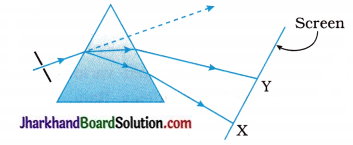
In the above figure a narrow beam of white light is shown to pass through a triangular glass prism. After passing through the prism, it produces a spectrum XY on a screen. State the colour seen at (i) X and (ii) Y.
Answer:
The colour seen at X is violet and that seen at Y is red.
(46)
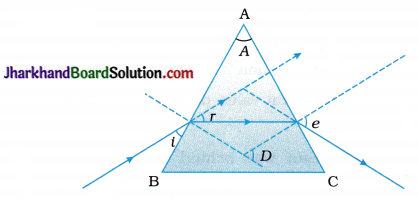
In the above figure, which angles are correctly marked?
Answer:
∠A and ∠e are correctly marked.
(47)
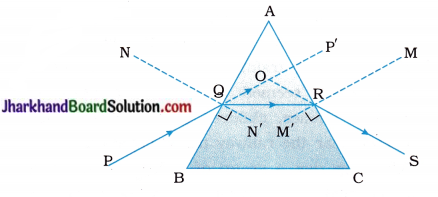
In the above figure (ray diagram), state the angle of incidence and the angle of deviation.
Answer:
∠PQN = i = Angle of incidence
∠P’OR = D = Angle of deviation
(48)

In the above figure (ray diagram), state angle of incidence, angle of emergence and angle of deviation.
Answer:
∠p = Angle of incidence
∠y = Angle of emergence
∠z = Angle of deviation
(49) What is the principle of the working of s the human eye?
Answer:
It is like a camera having a lens system forming an inverted, real image on the light |> sensitive screen (retina) inside the eye.
(50) On which factor does the colour of the scattered white light depend?
Answer:
Size of the particles of the medium : through which it is passing.
(51) Give the scientific names of the following parts of the eye :
(a) Carrying signals from an eye to the brain.
(b) A small opening (hole) in the middle of the iris.
Answer:
(a) Optic nerve
(b) Pupil
(52) A near-sighted person has a near point 25 cm and a far point 50 cm. Can he see clearly an object at a distance of: (i) 5 cm, (ii) 25 cm, (iii) 60 cm. Write ‘Yes’ or ‘No’ only.
Answer:
- No
- Yes
- No
(53) The near point of a far-sighted person is 50 cm.
Can the person see clearly an object at a distance of:
(i) 20 cm
(ii) ∞ (infinity)
Answer:
(i) No
(ii) Yes
![]()
(54) How much is our horizontal field of view (a) with one eye open
(b) with both eyes open?
Answer:
(a) about 150°
(b) about 180°.
(55) Which of the following have a wider s field of view?
(a) Animals having two eyes on the opposite 5 sides of their head or
(b) Animals having two eyes at the front of their head.
Answer:
(a) Animals having two eyes on the opposite 5 sides of their head or
Value Based Questions With Answers
Question 1.
Maull and Vlshva are best friends and they study in 4th grade. Recently, Mauli has been facing difficulty in reading the blackboard text from the last desk/bench. Vishva wonders why Mauli avoids sitting on the last desk/bench. On observation, Vishva found that Mauli often carries junk food in her lunch. Vishva has started sharing her lunch full of green vegetables and fruits with her. Mauli is now better and has also started taking a “balanced diet”.
- Name the eye defect Mauli is suffering from.
- What are two possible deformities related s to her eye defect?
- What values do you learn from Vishva and Mauli?
Answer:
- Myopia (near-sightedness)
- Lens defect (increased thinness i.e., excessive curvature of the eye lens) and Eyeball defect (elongation of the eyeball).
- Friendship, concern for each other, s importance of a balanced diet.
Question 2.
An eye camp was organised by the doctors in a village. They found that the eyes of imaged people in the village have the near point receded and the far point also gets reduced. Often aged people suffer from both myopia s and hypermetropia. Doctors (opthalmologists) provide these people spectacles of bi-focal lenses to correct the defects. The people were happy and grateful to the doctors.
(1) Name the eye defect from which the people were suffering.
(2) Give any two causes of this defect.
(3) What were benefits to organise such camps > in rural areas? Give two suggestions.
Answer:
(1) Presbyopia
(2) (a) Weakening of ciliary muscles
(b) Reducing ability of the lens to change the curvature.
(3) (a) To make people aware of eye diseases
(b) To tell people to take proper and balanced diet.
Question 3.
Four friends went to a picnic. The weather was pleasant. They played various games and then had snacks. Suddenly, Raju, one of them, observed seven colours in the sky. He said to others, “wow what a rainbow” !
Ram, one of them, asked him “What is a rainbow?” Raju then explained to all about its formation. After that everyone in the group thanked Raju for the knowledge, he had given to them.
(1) When Raju was facing the rainbow, where was the Sun?
(2) Which device can be used to obtain such a phenomenon?
(3) What moral value do you learn from Raju?
Answer:
(1) The Sun was behind Raju.
(2) A small prism. (Water droplets present in the atmosphere act like small prisms.)
(3) Knowledge increases by sharing, friendship, love and affection with nature.
Question 4.
In a beautiful valley, there was a village. When trains passed from the village, the whistle and the sound of train, mixed with the sound of waterfall, seemed to be very pleasant to everyone. Hence, children of that village used to play near the railway track. Once on a very light foggy day, a group of children found that a fish plate was missing from the track. As such, all the villagers were worried.
Prashant, one of the children, suddenly put his ear to the line and tried to know whether a train is coming or not. He knew a train is coming. He asked his friends to inform the railway cabin crew and he himself put off his red shirt and started running s towards the train, waving his red shirt. The driver and cabin man got the alert signal in time and thus a major accident was averted.?
(1) Name the two physical phenomena of science used by Prashant.
(2) Why did Prashant use his red shirt instead of any other coloured shirts?
(3 ) What moral values do you learn from Prashant?
Answer:
(1) (a) Sound travels through a medium.
(b) Scattering of light
(2) The red light is least scattered by fog or smoke so it can be seen from a large distance.
(3) (a) Proper knowledge and its application.
(b) Concern for others.
Question 5.
Millions of people of the developing countries of the world are suffering from corneal blindness. They can be cured by replacing the defective cornea with the cornea of a donated eye. A charitable society of your city has organised a campaign in your neighbourhood in order to create awareness about this fact.
(1) State the objective of organising such campaigns.
(2) Write one argument which you would give s to motivate the people to donate their eyes after death.
(3) List two values which could be developed in the persons who actively participate and < contribute in such programme.
Answer:
(1) The objective of organising such campaign is to help those people who are suffering from corneal blindness and they can be cured by replacing their defective cornea with the cornea of a donated eye.
(2) Come forward to participate in this compaign because, if someone gets his vision through your eyes, it is an incredible help as the eye is one of the most valuable sense organs through which an individual can achieve so many things in his / her life.
(3) The persons who actively participate and contribute in such programme are
- strong hearted
- very much helpful for the people living in such situations.
Question 6.
Mr Bharat’s 65 year old mother was complaining about blurred vision in both the eyes due to which she could not see things clearly. Mr Bharat took his mother to an eye hospital. The doctor examined her eyes carefully and concluded that she has a medical condition which could not be corrected by using any type of spectacle lenses and it required surgery. Her eyes were operated upon and she could then see once again properly.
(1) What could be the defect in the eyes of Mr Bharat’s mother?
(2) What happens to the eye lens during this defect? What is done during surgical operation of the eyes to restore the correct vision?
(3) What values do you learn from Mr Bharat in this episode?
Answer:
(1) The defect in the eyes of Mr Bharat’s mother is known as cataract.
(2) During the development of cataract, a membrane is gradually formed over both the eye lenses making the eye lenses cloudy. This makes the vision blurred. During surgical operation, the cloudy eye lenses are removed from the eyes and suitable artificial lenses are inserted in their place.
(3)
- Awareness and knowledge about the eye defects that can be cured by eye specialist doctors.
- Desire to mitigate the suffering of others (here mother).
- Sense of responsibility.
Question 7.
Amit is a domestic help (or maid) working at ; Mr Dave’s house. One day Amit complained to Mr Dave that he had difficulty in reading the letter which he had received from his s parents. Mr Dave, realising that Amit had an eye defect, took him to an eye specialist doctor.
The doctor tested his eyes carefully and told Amit to wear spectacles containing certain type of lenses having specified power, Mr Dave bought the required spectacles for Amit. By wearing this spectacle, Amit could read and write easily. He was very happy and thanked Mr Dave.
(1) What could be the eye defect Amit was suffering from?
(2) What could be the two possible reasons responsible for his eye defect? What type of lenses do you think the doctor recommended for Amit’s spectacles?
(3) What values are displayed by Mr Dave in this episode??
Answer:
(1) Amit was suffering from an eye defect called hypermetropia (far-sightedness) in ; which a person cannot see the nearby objects clearly though he can see the distant objects clearly.
(2) (a) Low converging power of the eye lens (because of the eye lens being less convex or less thick)
(b) Eyeball being too small (flat) (because of which the distance of the retina from the eye lens is less than normal).
The doctor recommended convex lenses for the spectacles of Amit.
(3) Mr Dave displayed the values of –
- awareness, which means having s knowledge of a situation or facts.
- concern for others (to mitigate their suffering).
- kindness and generosity.
![]()
Question 8.
Rohit is a car driver working for Mr Joshi. One day Rohit complained that he had difficulty in driving the car because he could not see the distant traffic clearly though he could see the nearby objects clearly. Mr Joshi took Rohit to an eye hospital. The eye specialist doctor checked and tested his eyes with various machines and gave him the name and power of the lenses to be worn as spectacles.
Mr Joshi paid for the required spectacles for the driver. By wearing these spectacles, the driver could now see even the distant vehicles and people on the road clearly. He thanked Mr Joshi for this.
(1) Name the eye defect Rohit is suffering from.
(2) What could be the two possible reasons for his eye defect? What type of lenses do you think the doctor recommended for Rohit’s spectacles?
(3) What values (or qualities) do you learn from Mr Joshi in this episode?
Answer:
(1) Myopia (near-sightedness) in which a person cannot see distant objects clearly though he can see nearby objects clearly.
(2) (a) High converging power of the eye lens (because of the eye lens being too convex or too thick).
(b) Eyeball may be too long (elongated) (because of which the distance of the retina from the eye lens is more than normal).
The doctor recommended concave lenses for the spectacles of Rohit.
(3) (a) General awareness (that an eye defect can usually be corrected by wearing spectacles containing suitable lenses).
(b) Concern for others (because Mr Joshi wanted to mitigate or remove the suffering of driver).
(c) Kindness and generosity.
Practical Skill Based Questions With Answers
Question 1.
Dispersion is caused by refraction and not by reflection. Why?
Answer:
White light is composed of seven colours having different wavelengths. And speed of different colours is the same in vacuum / air while in different media it is different.
Now, for a given angle of incidence, the angle of reflection is the same for all the wavelengths of white light, while the angle of refraction is different for different wavelengths.
Question 2.
A beam of white light falling on a glass prism gets split up into seven colours marked 1 to 7 as shown in the diagram.

(1) The colours at positions marked 3 and 5 are similar to the colour of the sky and the colour of gold (metal), respectively. Is the above statement made by a student correct or incorrect. Justify.
(2) Which of the positions shown above correspond approximately to the colour of (a) a brinjal, (b) danger signal, (c) neel (applied to clothes), (d) orange.
Answer:
(1) No, because 3 refers to yellow and 5 to blue colour of the spectrum.
(2) (a) 7 (b) 1 (c) 6 (d) 2.
Question 3.
When a beam of white light is passed through a triangular glass prism, it gets dispersed into its component colours. Why do we get these colours? In the given figure, the colours X and Y represent the extreme components of the spectrum. Identify X and Y.
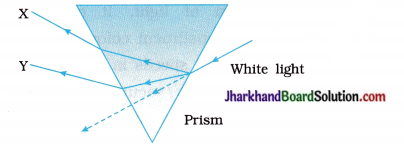
Answer:
(1) Different colours of light while passing through a prism bend through different angles with respect to the incident ray, as they travel with different speeds, this leads to dispersion of light.
(2) X – violet, Y – red
Question 4.
A narrow beam PQ of white light passes through a glass prism ABC as shown in the diagram.
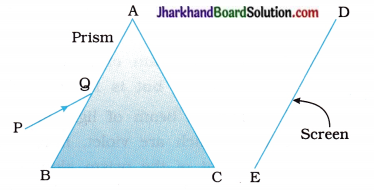
Trace it on your answer sheet and show the path of the emergent beam as observed on the screen DE.
(1) Write the name and cause of the phenomenon observed.
(2) Where else in nature is this phenomenon observed?
(3) Based on this observation, state the conclusion which can be drawn about the constituents of white light.
Answer:
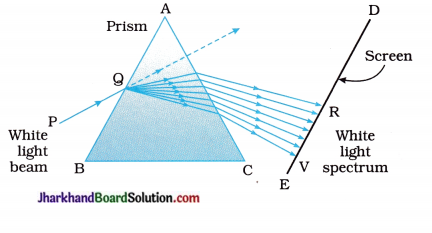
(1) The phenomenon of splitting of white light into its constituent colours is called dispersion of light. It occurs because different constituent colours of light travel with different speeds in a material medium (other than air /vacuum) and hence bend through different angles.
(2) In nature, this phenomenon is observed in formation of a rainbow.
(3) Based on the phenomenon of dispersion, we can conclude that –
- White light consists of seven colours.
- Violet light suffers maximum deviation and red light suffers minimum deviation.
Question 5.
(a) A narrow beam of white light is incident on three glass objects as shown below. Comment on the nature of the behaviour of the emergent beam in all three cases.

(b) There is a similarity between two of the emergent beams. Identify the two.
Answer:
(a) (1) The incident beam of light after refraction through the glass slab emerges parallel to the incident beam but is laterally shifted. No dispersion takes place in this case.
(2) The incident beam of light after refraction through the prism splits into a band of seven colours which are violet, indigo, blue, green, yellow, orange and red. These coloured rays emerge out of the prism along different directions and become distinct. Thus, in this case, dispersion of white light takes place.
(3) When the incident beam passes through the first prism, the prism splits it into a band of seven colours. These coloured rays are then incident on an identical inverted prism.
Then the recombination of the coloured rays takes place. The emergent beam of light is parallel to the incident beam but slightly shifted outward.
(b) The emergent beam in the cases (1) and (3) are similar. In both the cases, the emergent beam is parallel to the incident beam and is laterally shifted.
Memory Map:

